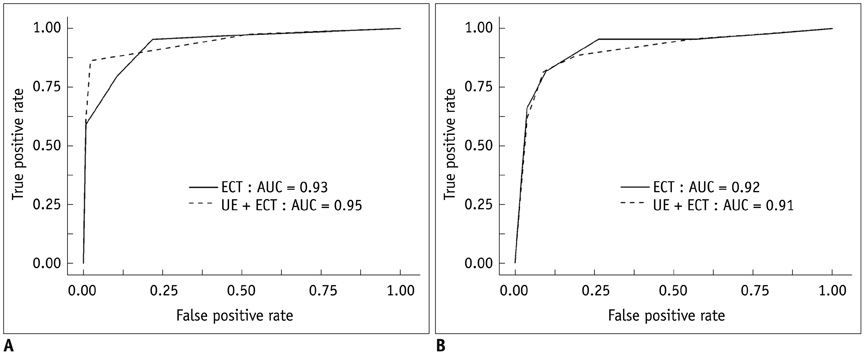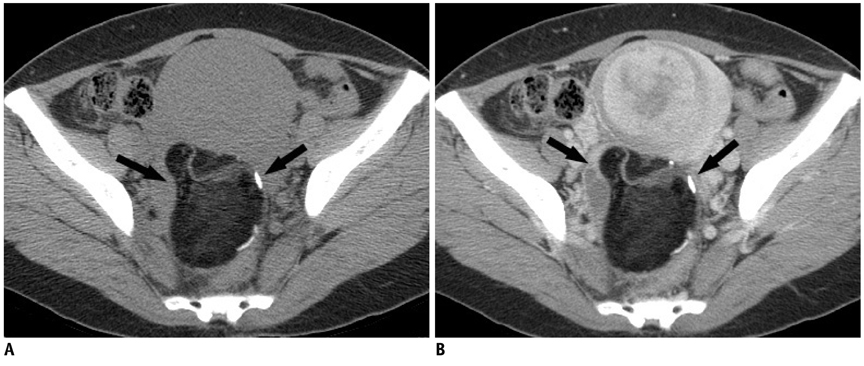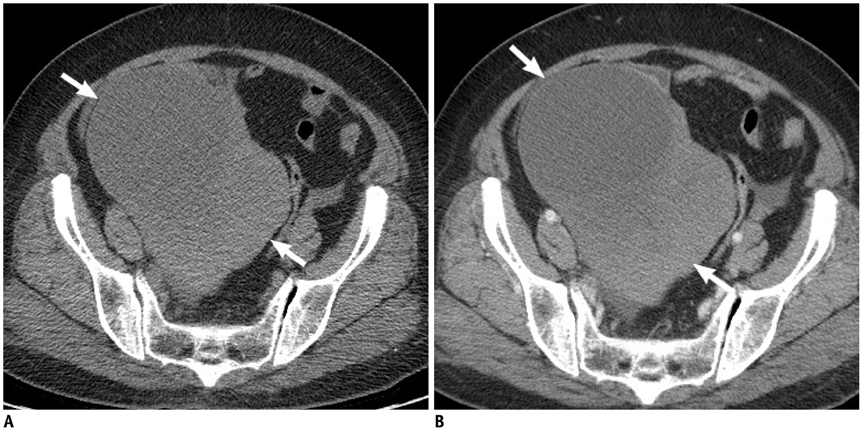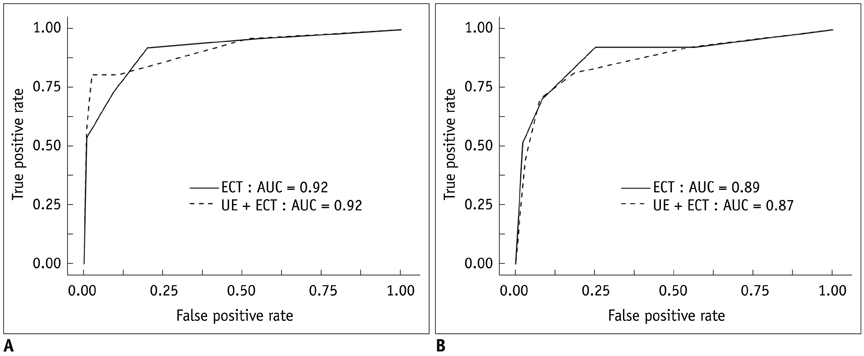Korean J Radiol.
2014 Feb;15(1):72-79. 10.3348/kjr.2014.15.1.72.
Multidetector Computed Tomography for the Assessment of Adnexal Mass: Is Unenhanced CT Scan Necessary?
- Affiliations
-
- 1Department of Radiology, Research Institute of Medical Science, Konkuk University School of Medicine, Seoul 143-729, Korea. radsijung@kuh.ac.kr
- KMID: 1711480
- DOI: http://doi.org/10.3348/kjr.2014.15.1.72
Abstract
OBJECTIVE
To compare the diagnostic performance and radiation dose between contrast-enhanced CT (ECT) alone, and combined unenhanced and contrast-enhanced CT (UE + ECT) for the assessment of adnexal mass.
MATERIALS AND METHODS
This retrospective study was approved by the Institutional Review Board. A total of 146 consecutive patients (mean age, 41.1 years) who underwent preoperative unenhanced and contrast-enhanced multidetector CT of the pelvis and had adnexal masses found at surgery were included. Two readers independently evaluated the likelihood of adnexal malignancy on a 5-point scale on two different imaging datasets (ECT alone and UE + ECT). The area under the receiver operating characteristic curve (AUC) was used to evaluate diagnostic performance. Radiation dose to patients was calculated by the volume CT dose index (CTDIvol) and the dose length products (DLP) on each dataset.
RESULTS
Of the total 178 adnexal masses, 133 masses were benign and 45 masses were malignant. For both readers, there is no significant difference of AUC values between ECT alone and UE + ECT for the detection of adnexal malignancy (reader 1, 0.93 vs. 0.95; reader 2, 0.92 vs. 0.91) (p > 0.05). The mean CTDIvol (12.6 +/- 2.2 mGy) and DLP (641.2 +/- 137.2 mGy) of ECT alone was significantly lower than the mean CTDIvol (21.5 +/- 2.7 mGy) and DLP (923.6 +/- 158.8 mGy) of UE + ECT (p < 0.0001).
CONCLUSION
The use of unenhanced CT scan in addition to contrast-enhanced CT scan does not improve the detection of adnexal malignancy, but increases radiation exposure.
Keyword
MeSH Terms
Figure
Reference
-
1. Salem S, White LM, Lai J. Doppler sonography of adnexal masses: the predictive value of the pulsatility index in benign and malignant disease. AJR Am J Roentgenol. 1994; 163:1147–1150.2. Spencer JA, Ghattamaneni S. MR imaging of the sonographically indeterminate adnexal mass. Radiology. 2010; 256:677–694.3. Hricak H, Chen M, Coakley FV, Kinkel K, Yu KK, Sica G, et al. Complex adnexal masses: detection and characterization with MR imaging--multivariate analysis. Radiology. 2000; 214:39–46.4. Tsili AC, Tsampoulas C, Charisiadi A, Kalef-Ezra J, Dousias V, Paraskevaidis E, et al. Adnexal masses: accuracy of detection and differentiation with multidetector computed tomography. Gynecol Oncol. 2008; 110:22–31.5. Zhang J, Mironov S, Hricak H, Ishill NM, Moskowitz CS, Soslow RA, et al. Characterization of adnexal masses using feature analysis at contrast-enhanced helical computed tomography. J Comput Assist Tomogr. 2008; 32:533–540.6. Tsili AC, Tsampoulas C, Argyropoulou M, Navrozoglou I, Alamanos Y, Paraskevaidis E, et al. Comparative evaluation of multidetector CT and MR imaging in the differentiation of adnexal masses. Eur Radiol. 2008; 18:1049–1057.7. Greess H, Nömayr A, Wolf H, Baum U, Lell M, Böwing B, et al. Dose reduction in CT examination of children by an attenuation-based on-line modulation of tube current (CARE Dose). Eur Radiol. 2002; 12:1571–1576.8. Tack D, De Maertelaer V, Gevenois PA. Dose reduction in multidetector CT using attenuation-based online tube current modulation. AJR Am J Roentgenol. 2003; 181:331–334.9. Paterson A, Frush DP, Donnelly LF. Helical CT of the body: are settings adjusted for pediatric patients? AJR Am J Roentgenol. 2001; 176:297–301.10. Divrik Gökçe S, Gökçe E, Coşkun M. Radiology residents' awareness about ionizing radiation doses in imaging studies and their cancer risk during radiological examinations. Korean J Radiol. 2012; 13:202–209.11. Goo HW. CT radiation dose optimization and estimation: an update for radiologists. Korean J Radiol. 2012; 13:1–11.12. Hur S, Lee JM, Kim SJ, Park JH, Han JK, Choi BI. 80-kVp CT using Iterative Reconstruction in Image Space algorithm for the detection of hypervascular hepatocellular carcinoma: phantom and initial clinical experience. Korean J Radiol. 2012; 13:152–164.13. Moritz JD, Hoffmann B, Sehr D, Keil K, Eggerking J, Groth G, et al. Evaluation of ultra-low dose CT in the diagnosis of pediatric-like fractures using an experimental animal study. Korean J Radiol. 2012; 13:165–173.14. Park EA, Lee W, Kang JH, Yin YH, Chung JW, Park JH. The image quality and radiation dose of 100-kVp versus 120-kVp ECG-gated 16-slice CT coronary angiography. Korean J Radiol. 2009; 10:235–243.15. Stevens SK, Hricak H, Stern JL. Ovarian lesions: detection and characterization with gadolinium-enhanced MR imaging at 1.5 T. Radiology. 1991; 181:481–488.16. Obuchowski NA. Nonparametric analysis of clustered ROC curve data. Biometrics. 1997; 53:567–578.17. Landis JR, Koch GG. The measurement of observer agreement for categorical data. Biometrics. 1977; 33:159–174.18. Togashi K. Ovarian cancer: the clinical role of US, CT, and MRI. Eur Radiol. 2003; 13:Suppl 4. L87–L104.19. Liu J, Xu Y, Wang J. Ultrasonography, computed tomography and magnetic resonance imaging for diagnosis of ovarian carcinoma. Eur J Radiol. 2007; 62:328–334.20. O'Malley ME, Halpern E, Mueller PR, Gazelle GS. Helical CT protocols for the abdomen and pelvis: a survey. AJR Am J Roentgenol. 2000; 175:109–113.21. Killius JS, Nelson RC. Logistic advantages of four-section helical CT in the abdomen and pelvis. Abdom Imaging. 2000; 25:643–650.22. Urban BA, Fishman EK. Tailored helical CT evaluation of acute abdomen. Radiographics. 2000; 20:725–749.23. Johnstone PA. ACR appropriateness criteria. Int J Radiat Oncol Biol Phys. 2008; 70:1303–1304.24. Gatreh-Samani F, Tarzamni MK, Olad-Sahebmadarek E, Dastranj A, Afrough A. Accuracy of 64-multidetector computed tomography in diagnosis of adnexal tumors. J Ovarian Res. 2011; 4:15.25. Tsushima Y, Yamada S, Aoki J, Motojima T, Endo K. Effect of contrast-enhanced computed tomography on diagnosis and management of acute abdomen in adults. Clin Radiol. 2002; 57:507–513.26. Guite KM, Hinshaw JL, Ranallo FN, Lindstrom MJ, Lee FT Jr. Ionizing radiation in abdominal CT: unindicated multiphase scans are an important source of medically unnecessary exposure. J Am Coll Radiol. 2011; 8:756–761.
- Full Text Links
- Actions
-
Cited
- CITED
-
- Close
- Share
- Similar articles
-
- Added Value of Using a CT Coronal Reformation to Diagnose Adnexal Torsion
- Periureteral Varices with Accompanying Pyelitis Diagnosed by 3-Dimensional Reformatted Technique of the Multidetector Row CT: A Case Report
- Follicular Dendritic Cell Sarcoma of the Omentum: Multidetector Computed Tomography Findings
- MDCT Application of Thoracic Imaging
- Multidetector Row Computed Tomography: 'Principles and Clinical Applications'







